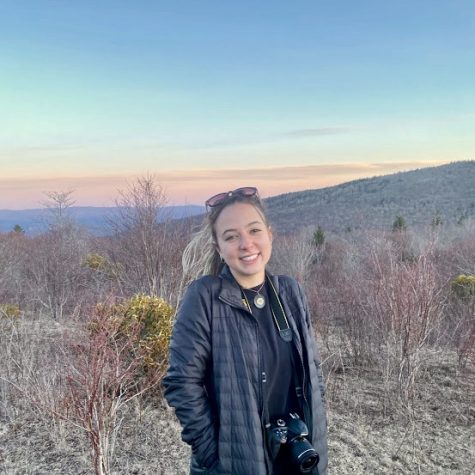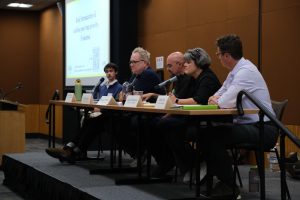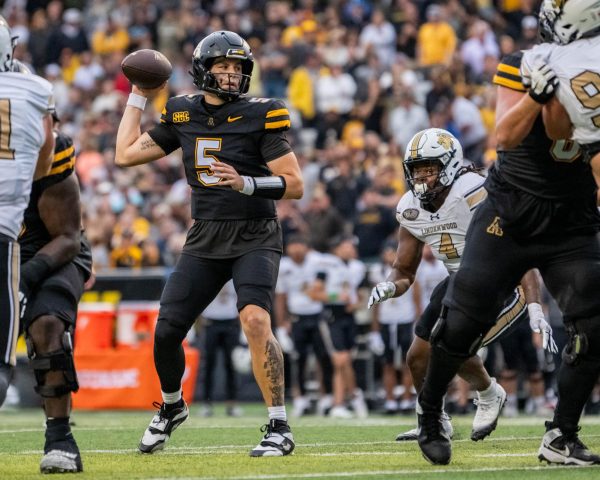App State advances sustainability goals year after AppCap 1.0 plan
March 15, 2022
A year after the finalization of App State’s climate action plan, the university has increased its purchased renewable energy and developed sustainable behavior programs.
The plan, AppCAP 1.0, was finalized March 5, 2021 and includes 81 mitigation strategies working to address issues in three categories: sourcing, efficiency and behavior and institutional change.
“I think this is probably our best, most cohesive effort to wrangle all the tentacles of effort around the university into one spot and start to create a clear path and road map as to how we’re actually going to get to the end goal of this thing,” said Jim Dees, data and assessment specialist in the Office of Sustainability and co-writer of the plan.
One of the accomplishments in the past year was the creation of an energy council, which Dees said is in charge of several sourcing-related strategies.
Energy manager Jonathan Pierson is working on two campus lighting projects to increase the amount of LED bulbs.
Pierson said students in the Renewable Energy Initiative conducted a lighting assessment in the ROTC office in Varsity Gym to replace existing fluorescent lights with LED bulbs. A similar and larger-scale project taking place in Holmes Convocation Center will replace almost 2,000 light bulbs with LED alternatives.
Pierson said he is working on building automation systems to save energy and improve efficiency.
“I do a lot of work with our building automation system that controls our HVAC systems, so we’re not heating, conditioning, cooling when nobody’s there,” Pierson said. “After everybody leaves for the day, we want to make sure we’re turning it off. That’s the single easiest, cheapest way to save energy is just to turn it off when no one’s there.”
The future Innovation District is not included in the plan as an efficiency or sourcing strategy, though Dees said all of its buildings will be carbon neutral.
Dees said the budget is a major part of many of the mitigation strategies because carbon-free sources are more expensive than traditional energy sources. With efficiency and sourcing-related costs, though, there is a quick payback.
“If you buy an economizer and install it in your boiler, you’re going to see an immediate change on next month’s heating bill,” Dees said.
Chief Sustainability Officer Lee Ball said in an email that the university is in the early stage of developing an AppCAP 2.0 version.
Dees described the 2.0 version as a refinement of the plan after discovering what did and didn’t work in the past year.
Ball, chair of the AppCAP 1.0 planning process, said there is no timeline for when the university will reach carbon neutrality, but the plan is designed to change as needed.
The Working Group II released their contribution to the Intergovernmental Panel on Climate Change Sixth Assessment Report March 1, detailing if fossil fuel emissions continue at current rates, the global temperature will cross the 1.5 degree threshold. This is the second of three working groups compiling the completed sixth assessment report.
The 1.5 figure refers to a global temperature increase, in Celsius, above pre-industrial levels.
“The global urgency is valid and we hope to align our efforts to contribute to the global effort to prevent a 1.5 increase rather than contribute to causing it,” Ball said.
The Office of Sustainability finished developing GreenSuite, the university’s collection of engagement programs designed to help move faculty, staff and students toward sustainable living, within the past year. This is one of the plan’s completed behavioral strategies.
The GreenSuite program includes more sustainable practices within residence halls, travel, events, the workplace, purchasing and labs. It also includes a general living guide.
Jennifer Maxwell, sustainability programming director for the Office of Sustainability, oversees the behavior-related mitigation strategies, including those within GreenSuite.
Maxwell said future plans include developing sustainable purchasing policies for the university, including training purchasing personnel on those guidelines. She also hopes to increase GreenSuite engagement.
A 2013 study found two-thirds of industrial greenhouse gas emissions were emitted by 90 companies. In contrast, individual actions and pollution, such as plastic straws, for example, constitute 0.025% of the 8 million tons of plastic found in the oceans as of 2020.
Maxwell said despite corporate changes being more impactful than individual people’s behavioral changes, both are equally important.
“There’s certainly a lot of evidence out there that the behavioral modification piece does contribute significantly,” Maxwell said. “If everybody is shifting their habits a bit to be more sustainable, then that certainly allows for an increase in demand for things as well.”
Dees said while it is important to lead by example and lower the university’s carbon footprint, App State becoming carbon neutral will not “change the course of history.”
“That’s where that change is going to have to happen; in the people, the future leaders and the next generation,” Dees said. “And so if we’re influencing that next generation positively to make the right decisions, then I think we’re onto something. It’s not the specifics of our carbon being erased from the world that’s going to solve this, it’s you guys.”
Additional information about the plan and mitigation strategies can be found here.














continually disillusioned • Mar 16, 2022 at 7:44 am
Ahh yes. The AppCAP. AppState’s vision board of aspirations. Cause it sure as heck ain’t a plan.
I think it’s worth noting that AppState could achieve “simple neutrality” for an exceedingly low lost (compared to how much cash is flushed down the drain in other areas.) Simple neutrality essentially means purchasing renewable electrons to offset the current use of fossil fuels. It is not a solution by any means, but it can work as a stepping stone as the university transitions to a low carbon future, so that in the meantime we are doing everything possible to shed emissions. Because as it stands right now? We ain’t gonna hit our targets until after 2100…
About the cost: For the low low price of $1 million/year, AppState could *right now* purchase 100% of our electricity from renewable energy resources. This is equivalent to ~4%(!) of the ANNUAL LOSSES incurred by the Athletics Dept., which consistently runs at a deficit to the tune of over $20 million each and every year. Yes you read that right. For just ~4% of a single year’s worth of financial losses incurred by Athletics, AppState could purchase 100% renewable electricity. That alone would shed ~30% of our direct carbon emissions.
For another ~$3.5 million, AppState could offset all of the carbon emissions associated with our heating (which is almost entirely via natural gas.) So, essentially, for just under 20% of the ANNUAL LOSSES incurred by Athletics, we could both offset 100% of our electric AND heating, which together account for 70% of our direct carbon emissions.
Heck, if we really wanted to tackle this problem, we could take a look at the top 20 highest paid employees on campus, all of them coaches and admins. Just reducing their pay to what an AVG professor makes could help fund the bulk of these costs. And if that’s not enough pay for them, then maybe they can explain to all of us how a full-time professor who is actually helping carry out App’s stated mission (*education*) is supposed to survive.
The fact that this is not being discussed openly is an absolute disservice to every member of the Appalachian community. The fact that students are forced to foot the bill to subsidize the complete economic disaster that is Athletics, to the tune of ~$1000/student/year, is a complete and utter sham (scam, really.)
AppState is not a bastion of sustainability. There are some amazing academic programs focused on sustainability, and some wonderful and hard-working folks focused on these problems, a few of them interviewed in this very article. But the university itself does next to nothing in terms of pushing these priorities forward, nor giving the proper support that is needed. The sustainability office has less than 10 folks working on this. That alone ought to highlight how little the university cares, considering how much completely unnecessary administrative bloat we see in other areas. The vast majority of sustainability projects on campus have been fully funded via REI, using student money and student work, NOT by the university.
AppState as a university is really good at one thing however: green-washing and using sustainability as nothing more than a buzzword and an advertising tool.